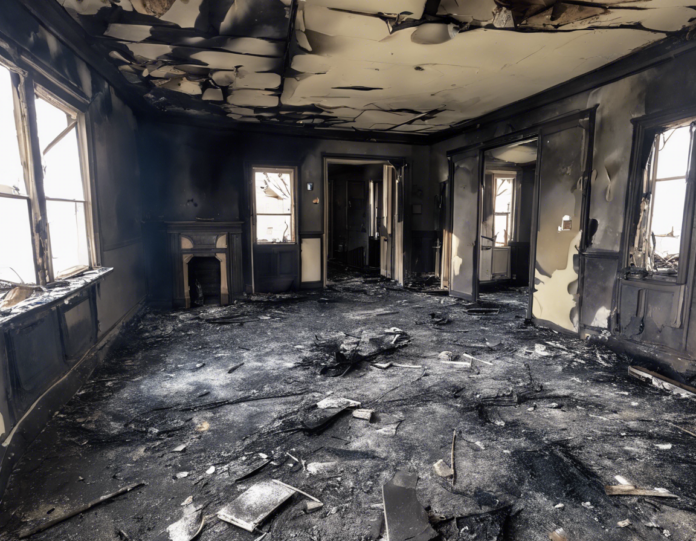The aftermath of a fire can be devastating, leaving behind a trail of destruction and damage that requires thorough cleanup and restoration. Post-fire cleanup is a crucial step in the recovery process, as it not only helps in eliminating health hazards but also paves the way for rebuilding and renewal.
Understanding Fire Damage
Fires can cause extensive damage to buildings, homes, and personal belongings. It is essential to understand the different types of damage that can result from a fire:
Structural Damage
- Charring: This occurs when materials are exposed to extreme heat and flames, causing a blackened, burned appearance on surfaces.
- Soot and Smoke Damage: Smoke can penetrate deep into building materials and furniture, leaving behind a pungent odor and dark residue.
- Water Damage: Water from firefighting efforts can exacerbate the damage by causing mold growth and weakening the structure.
Health Hazards
- Air Quality: Post-fire, the air quality can be compromised due to smoke, soot, and other contaminants, leading to respiratory issues and other health concerns.
- Mold Growth: Moisture from firefighting efforts can create an ideal environment for mold to flourish, posing health risks to occupants.
The Cleanup Process
Safety First
Before beginning the cleanup process, it is essential to ensure the safety of all individuals involved. This may involve wearing personal protective equipment (PPE) such as masks, gloves, and goggles to prevent exposure to harmful substances.
Assessing the Damage
A thorough assessment of the damage is necessary to determine the extent of the cleanup required. This may involve working with professionals such as restoration companies or fire damage specialists who have the expertise and equipment to assess the damage accurately.
Removal of Debris
The first step in the cleanup process is the removal of debris, including charred materials, furniture, and other items that are beyond repair. This is crucial to create a clean and safe environment for subsequent restoration efforts.
Cleaning and Disinfecting
Cleaning and disinfecting surfaces is essential to remove smoke residue, soot, and other contaminants. Specialized cleaning agents and equipment may be required to ensure thorough cleaning and decontamination.
Odor Removal
Smoke odors can linger long after the fire has been extinguished. Employing techniques such as ozone treatment, thermal fogging, or air scrubbing can help in eliminating stubborn odors and improving indoor air quality.
Restoration and Reconstruction
Once the cleanup is complete, the focus shifts to restoration and reconstruction. This may involve repairing structural damage, replacing damaged materials, and restoring the property to its pre-fire condition.
Professional Help vs. DIY Approach
While some minor fire damage cleanup tasks can be tackled by homeowners, it is advisable to seek professional help for more extensive damage. Here are some factors to consider when deciding between a DIY approach and hiring professionals:
- Extent of Damage: Severe fire damage may require specialized equipment and expertise that professionals possess.
- Time and Resources: Professional cleanup companies have the resources and manpower to expedite the cleanup process efficiently.
- Health and Safety: Professionals are trained to handle hazardous materials safely, reducing the risk to occupants.
FAQ: Frequently Asked Questions
Q1: Is it safe to enter a property after a fire?
A1: It is crucial to wait for authorities to declare the property safe before entering, as there may be structural damage or health hazards present.
Q2: How soon should cleanup begin after a fire?
A2: Prompt cleanup is essential to prevent further damage from smoke, soot, and water. Contacting cleanup and restoration professionals immediately is recommended.
Q3: Can belongings be salvaged after fire damage?
A3: Depending on the extent of damage, some belongings may be salvageable through professional cleaning and restoration techniques.
Q4: Will insurance cover the cost of post-fire cleanup?
A4: Most homeowner’s insurance policies cover fire damage cleanup and restoration. It is advisable to contact your insurance provider to understand the extent of coverage.
Q5: How long does the post-fire cleanup process take?
A5: The duration of the cleanup process depends on the extent of damage. It can range from a few days to several weeks for more severe damage.
In conclusion, post-fire cleanup is a critical step in the recovery process after a fire incident. Understanding the types of damage, the cleanup process, and the importance of safety can help in navigating the challenges of restoring a property to its pre-fire condition. Seeking professional help and following proper guidelines can ensure a thorough and effective cleanup, ultimately paving the way for renewal and rebuilding.


Recent comments